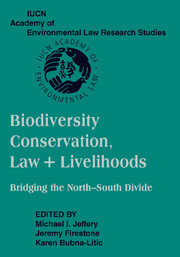Description
Biodiversity Conservation, Law and Livelihoods: Bridging the North-South Divide
IUCN Academy of Environmental Law Research Studies
IUCN Academy of Environmental Law Research Studies Series
Coordinators: Jeffery Michael I., Firestone Jeremy, Bubna-Litic Karen
This book presents a broad range of global perspectives on biodiversity conservation and the maintenance of sustainable cultures.
Language: English
Subject for Biodiversity Conservation, Law and Livelihoods: Bridging...:
Biodiversity Conservation, Law and Livelihoods: Bridging the North-South Divide
Publication date: 07-2012
Support: Print on demand
Publication date: 07-2012
Support: Print on demand
Biodiversity conservation, law & livelihoods: bridging the North-South divide (IUCN Academy of environmental law research studies)
Publication date: 01-2008
612 p. · 18.4x26 cm · Hardback
Publication date: 01-2008
612 p. · 18.4x26 cm · Hardback
Description
/li>Contents
/li>
The IUCN Academy of Environmental Law Research Studies' third colloquium of 2005 brought together more than 130 experts from 27 nations on nearly every continent. This book brings together a number of the papers presented there and offers a global perspective on biodiversity conservation and the maintenance of sustainable cultures. It addresses issues from international, regional, and country-specific perspectives. The book is organized thematically to present a broad spectrum of issues, including the history and major governance structures in this area; the needs, problems, and prerequisites for biodiversity; area-based, species-based, and ecosystem-based conservation measures; the use of components of biodiversity and the processes affecting it; biosecurity; and access to and sharing of benefits from components of biodiversity and their economic value.
Acknowledgments; Message from Kofi Annan, Secretary-General of the United Nations; 'Macquarie Statement' (adopted by consensus at 3rd IUCN Academy Colloquium); Introduction; Part I. The Context: 1. Environmental law forty years later: looking back and looking ahead; 2. Biodiversity and international law: historical perspectives and present challenges - where do we come from, where are we going?; 3. Some observations on the IUCN, the Earth Charter, and global governance; 4. The changing role of law in the pursuit of sustainability; Part II. Biodiversity: Its Conservation (A) Needs, Problems, Pre-Requisites: 5. Biodiversity conservation in the context of sustainable human development: a call to action; 6. Legal and paralegal rules for biodiversity conservation: a sequence of conceptual, linguistic and legal problems; 7. Future directions in conservation of biological diversity: an interdisciplinary approach; (B) Implementation of the CBD: 8. Experience, mistakes and challenges: an overview about the implementation of the convention on biological diversity in Brazil; (C) National and Regional Legal and Institutional Tools and Regimes: 9. EC law and biodiversity; 10. Regionalising community-based biodiversity conservation: institutional antinomy in Pacific Island environmental governance?; Part III. Conservation Measures (A) Area-Based: 11. The recent NSW experience, from regional forest agreements to Brigalow and the introduction of the Community Conservation Area; 12. Local people's perceptions and attitudes towards Nech-Sar National Park, Ethiopia; 13. Japanese MPA's at a turning point: nomination of Shiretoko for World Heritage status; (B) Species-Based: 14. 10 years of threatened species legislation in NSW- what are the lessons?; 15. Sanctuaries, protected species and politics: how effective is Australia at protecting its marine biodiversity under the Environment Protection and Biodiversity Conservation Act 1999?; 16. Legal stewardship of mountain regions: the emerging eco-regime; Part IV. Uses of Components of Biodiversity: 17. Legal framework for the ecological and biodiversity needs of soil: progress towards an international instrument for the sustainable use of soil; 18. The Ghanaian forestry regime: bridging the gap between the north and south; 19. Bridging the dominant-indigenous peoples cultural divide: reflections on Makah whaling; Part V. Processes Affecting Biodiversity: (A) Global Warming: 20. Do biodiversity and climate change laws mix?; 21. Emissions trading: a fantasy for China to combat global warming? From a political standpoint; (B) Land Management: 22. A brief historical comparison of the public land disposal policies in Brazil and in the United States; 23. Protecting ecological functions - ecological function zoning and its conservation zones in the PRC; 24. The successful eco-grass project and the policy and legal issues met and solved; Part VI. Biosecurity Issues (A) Invasive Alien Species: 25. Prevention and control of alien invasive species: China's implementation of CBD (B) GMOs: 26. Who is to blame? Liability and redress schemes related to GMOs; 27. The reality and effect of 'advance informed agreement' under the Cartagena Protocol; Part VII. Access and Benefit Sharing: (A) The Situation in Antarctica: 28. Access, obligations and benefits: regulating bioprospecting in the Antarctic; (B) Indigenous Intellectual and Cultural Property Rights: 29. Biotechnological innovations, genetic resources and traditional knowledge: current developments at the World Intellectual Property Organisation; 30. Sharing all the benefit: the challenge of legal recognition of indigenous intellectual and cultural property rights in the Fiji Islands.
© 2024 LAVOISIER S.A.S.




